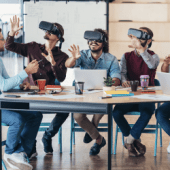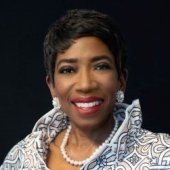Cambridge dean: A revolution is coming! How to prepare for a radically new working world
IN BRIEF
- Business leaders need to abandon old clichés about jobs and embrace the principles of distributed work and the virtual corporation.
- It’s possible that people may pursue not just one career, profession or occupation over their lifetimes, but rather two or three.
- We should move away from concepts such as “remote work” or “hybrid work,” and embrace smarter ways of organizing work.
“Revolutions are not made; they come,” said the American abolitionist, Wendell Phillips. “A revolution is as natural a growth as an oak. It comes out of the past. Its foundations are laid far back,” he noted. That’s exactly the nature of the revolution underway in the world of work.
There’s certainly been no shortage of published reports and research from think tanks and foundations on the future of work, especially since the pandemic accelerated many of the trends that had already begun. It’s easy to think that the pandemic is behind this seemingly sudden transformational outburst, but it’s really being driven by long-standing forces of a demographic, economic and technological kind. Within a decade, the nature of work and the workplace may bear little resemblance to the situation today.
To take advantage of the coming revolution, business leaders and companies need to abandon old clichés about jobs and embrace the principles of distributed work and the virtual corporation.
The revolution is being driven by the confluence of different trends. As people see their lifespan and health span increase, they start to think differently about the periods they spend learning, working and resting. For a growing proportion of the labor force, the sequence from school to work to retirement may no longer be the only pathway. Meanwhile, no measure of nationalism or populism is capable of fully erasing the long-standing dynamic of economic globalization, whereby developments in one part of the world affect those in others. And a panoply of technologies—social media, digital platforms, AI, blockchain, the metaverse—continue to undermine classic notions of time and space, allowing for novel ways of connectivity, interaction and collaboration hitherto thought to be whimsical and unrealistic.
In order to see the forest for the trees, we need to engage in lateral thinking; that is, examine how trends that appear to be unrelated converge on one another to create a new world of work. Consider that sheer technological change makes knowledge obsolete much faster than in the past while people are living ever longer and healthier lives. If one connects the dots across those technological and demographic trends, it becomes entirely possible that people may pursue not just one career, profession, or occupation over their lifetimes, but rather two or three. After 20 years of work, going back to school may be required to keep one’s job or rotate into a new one.
Another example of lateral thinking involves barriers to immigration and the increase in remote work. The pandemic has accelerated both, although the former was already on the rise due to geopolitical tensions, the political backlash against immigration in the United States and Europe, and events such as Brexit. Job vacancies are very high and unemployment remains very low, at least in the United States, to the point that the number of jobless individuals for each job opening is at its lowest point in two decades. Cross-border remote work offers a way for companies to employ the talent they need without having to ask foreigners to relocate or the government to offer them work visas.
A third illustration refers to the pensions crisis and the multigenerational workplace. As more people above the age of 65 postpone retirement, or do not retire fully due to the insufficiency of pensions and savings, we’re seeing four or even five different generations of employees working side by side. Forward-looking firms as diverse as BMW, The Hartford, Pitney Bowes and Estée Lauder are capitalizing on this trend by leveraging the skills of different generations within their teams and workplaces.
It’s often said that team performance can be enhanced by combining the energy and enthusiasm of people in their twenties and thirties, the experience and good judgment of those in their forties and fifties, and the mental fortitude and perspective of people in their sixties and beyond. “A multigenerational team offers a diversified way of looking at a project or problem,” argues Helen Dennis, a specialist on the topic. “The more thoughts you have, the greater the advantage you have to accomplish your objective.”
Here are some key developments business leaders and executives should be focused on over the next decade. They will transform work as we know it:
Smart work
We should move away from concepts such as “remote work” or “hybrid work” and instead embrace smarter ways of organizing work. Research shows that, during the pandemic, remote workers are spending more hours at their home desks but without necessarily producing more. The future of work cannot be merely remote or hybrid but rather must be tech-enabled, flexible and multigenerational. Greater creativity and productivity stem from enabling new connections and collaborations that facilitate information exchange and experience sharing, precisely what Microsoft found to be missing in its own remote workforce. The potential lies not in where people work but in how they work.
A global market for talent
As employers and employees gain more experience with smart work, a new universe of possibilities opens up, especially in the form of people working for far-flung companies from the comfort of their home or shared workspaces thousands of miles away. Globally distributed work and virtual companies will match job opportunities with the best talent available on a worldwide basis. Workers with differentiated skills in high demand will benefit from the emergence of a global market for talent, while those who do not possess such skills will see their opportunities and wages decline. That’s why we need to make sure that tech-enabled work from a distance does not leave anyone behind.
Shorter, multiple careers
If people’s working lives will extend for five or more decades, we cannot expect them to be in the same line of work for that long. Many people will prefer to switch careers while others will be forced to do so due to technological change. A new approach to life and work based on shorter, multiple career pathways cannot possibly happen without educational institutions, governments and companies changing the way in which they view, develop and utilize the many talents that people possess. Wholesale institutional and organizational transformations are essential to unleash the full potential of tech-enabled, flexible, multigenerational work.
On-site workforce resilience
No matter how hard we try, we will need nearly half of the labor force to show up for work at factories, transportation hubs, logistics centers, hospitals and schools—unless automation progresses faster than anticipated, which would displace huge amounts of workers from their jobs. The pandemic has prevented many workers from showing up in their place of work due to exposure to the virus or actual illness. Supply chains have been disrupted to the point that inventory levels at American companies are at 30-year lows. In the future, on-site work needs to be more resilient to unforeseen disruptions. Along the way toward the knowledge-based economy, we have taken manual work for granted. Only after a series of geopolitical crises, natural disasters and public health emergencies in close succession have we come to the realization that we need to nurture a dynamic manual workforce with the ability to adapt to changing circumstances.
The work revolution has barely started. We are on the verge of transformations of a magnitude not seen since the onset of the Industrial Revolution nearly 300 years ago, when workers were made to labor under one roof, machines dictated the pace of work, and the division of labor and the separation of doing from thinking became the core workplace organizing principles. Demographic, economic and technological forces larger than us underpin these changes. The crucial task for the next decade is to ensure that they result in better outcomes for both companies and workers.
Workers with differentiated skills in high demand will benefit from the emergence of a global market for talent, while those who do not possess such skills will see their opportunities and wages decline.
































